- Display the difference in time between the time you’ve spent on the page and the time the person who’s been on the page the longest has been on the page. Changes once that oldest person leaves, so eventually the time difference would be 0sec if you became the oldest person. –> place in line.
- You have your own slider (like for volume — 1-100 scale) and you get a celebratory notification if your spot on the slider is the same as your partner’s spot on the slider.
- A new chair icon placed at the user’s choice in a designated space for the number of people “sitting in a room with you” –> virtual copresence, dibs on your spot.
- “Warmer/colder search” like Marco Polo –> color changes from red to blue shades as your position in a circle moves closer to another person’s position. Hide and seek to the mystery location of your partner.
- Dense grid of “lights” like an LED grid –> clicking on a spot turns it on and off, creates a rudimentary pixelated image.
- Light increases brightness/radius with the more people who join a page –> would hit max diameter before max opacity. Every person who enters the space brings their own “candle”.
Category Archives: Uncategorized
Project 7: Ideas (to interact (again))
- only happy/sad buttons, changes background,
- happy/sad buttons, one gets the buttons, one gets the background color
- only get a minute to post something, never ending story, another view of whole story
- mad lib style, one writes and marks nouns/adjectives/verbs, other fills in verbs
- can’t double text, can’t speak until spoken to
- setting up prisoner’s dilemma
- noise button, must press button along with other person to stop noise
- background changes color depending on the amount of users on page
- post things, not people on social media
Jayson & Rachel Project 7 Ideas
What are its inputs and outputs? It’s mechanisms of communication?
Resist the desire to grow the system—focus on one single exchange.
What does your system say about networked communication?
How does limiting interaction to one pathway expand the potential of that pathway over its previous usefulness (e.g. as one of many mechanisms of interaction)?
1. remove login/signup function
2. remove/obscure usernames
3. remove date and/or time of posts
4. implementing expiration date on people you follow – based on how active you are with said person on website
5. when accessing certain articles/posts on website (i.e political or government news or editorials) you are required to answer a basic or common sense question before you are allowed to share, like or comment on said article/post
6. charge people a certain amount of money depending how active they are on site
7. a counter that keeps track of every “__” that appears on your newsfeed
8. an account that gets deleted if not accessed once every two weeks – to prevent it from being deleted (if not accessed within two weeks), you must pay a fine that increases each time you encounter said fine.
Project 7 Ideas-Chase&Maggie
- Keeping the ball afloat game-multiple users pressing a button to keep a ball in the air and see how long they can keep it up.
- Two piles, pushing a button will remove one item from a pile and add it to the other. Users decide how they want to balance the piles.
- Chat function-create a story: two users make a story one word at a time alternating turns, you can view the stories and vote for which you like.
- Blind Mad Libs- people log onto the site and are presented with a box to input a verb, adjective, adverb, noun, etc. Then after all the blanks had been filled they can view the story with what other people have inputted.
- Similar to idea two, large group of people on land and you can press a button to put them on a boat. If you put too many on the boat it sinks and resets.
- The screen is a color, you control the amount of red, green, blue in the image by pressing buttons, as well as the tint/shade.
- Virtual garden: people water the plants and provide sunlight. Plants die if they are neglected for too long.
- Snake game: multiple people controlling it a la twitch plays pokemon, but much harder.
8 Ideas
Link to Stephanie’s post: http://arts445.courses.bengrosser.com/8-ideas/.
6 Ways to Improve the Internet
Link to Stephanie’s post: http://arts445.courses.bengrosser.com/6-ways-to-improve-the-internet/.
8 Ideas
Partners with Eva
- Memes (which is best)
- Exchanging drawings / dots
- How to place a circle at a specific location on the webpage (css options, absolute positioning…)
- How to draw a circle (div: square with border-radius)
- Make html page of dots with divs absolute positioned
- Tug of War
- 1 second sound
- Collaborative story
- Stacking blocks
- One person has a pencil, the other has an eraser
- Lights on / off
- Twitter – tweet
6 Ways to Improve the Internet
Partners with Eva
- Better report / block functions
- Clearer site layouts and algorithms
- Personal censor features (ex: if u don’t want to see politics politics will be hidden; like tumblr savior)- easier to cater sites to the user
- Remove shady websites and links that give computers viruses or steal data / better way to protect yourself
- Harder to steal someone elses posts
- Less ads per page
Changes to Social Media
- Actual control over the content we see – technically we can choose who we follow and what we like, but there’s so much junk overflow we haven’t opted into from platform suggestions, rehash of friend’s activity.
- Following from choosing the content we want to see, less advertisements. We’d be open to paying for content if it meant we would stop being barraged with advertisements that don’t apply to me or that we don’t care about.
- Stigmas/social practices about content creation. There’s pressure to post a certain type of image at a certain frequency, and deviating from that results in a social faux pas and criticism. There’s a reward system for creating content within the defined parameters of the system.
- Changes to the user interface that disrupt the experience of the user rather than enhance or streamline it. This often results in the (extremely irritating) derision from the higher social media powers that be where they know better than us silly, complaining children.
- Educating users on what’s being done with their data, along with more thorough examples and tutorials for security settings.
- Even though its technically the property of each company, we’d love to know how the algorithms work behind the scenes.
- Kate and Jess
Observe 4/2
My sister sent me this one.
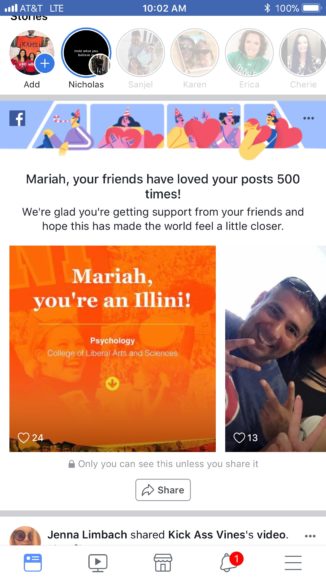
I thought it was really interesting since it shared not only the memories but also included that the posts reached 500 likes. I also thought the wording of the smaller text was strange and made it seem like “Likes” are equivalent to people sending their love and support and that thanks to her posting, her WORLD is feeling a little closer.
Project Observe
For my observe I did the LinkedIn app. I think it’s a decent app and that it does an okay job doing what its desktop counterpart does. However that is something that bothers me with the app. I think it tries to push everything into a mobile format. I think the app suffers from that and becomes to cluttered. I don’t think it is as clean as it can be and see room for improvement. I expect a revamped update to come eventually, but like I said, it does do an okay job. I think the very unorganized and random feed is really hard to follow and therefore care about. Similarly, the find new connections is very weird knowing all your friends know all these people but you don’t. LinkedIn does a good job to help get you to employers and helps push your name which is something to be thankful of. Something it pushes quite often is their premium membership. It is constantly popping up and not pleasant when you are doing searching and browsing for things. It is cool to offer a premium i suppose but the free version offers just enough. I think it does a good job and worth having, it never hurts making connections and having a decent platform for employers to find you.

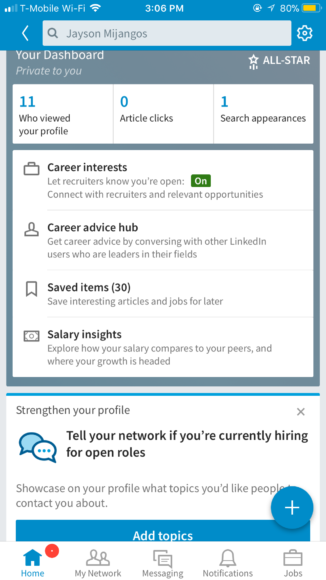

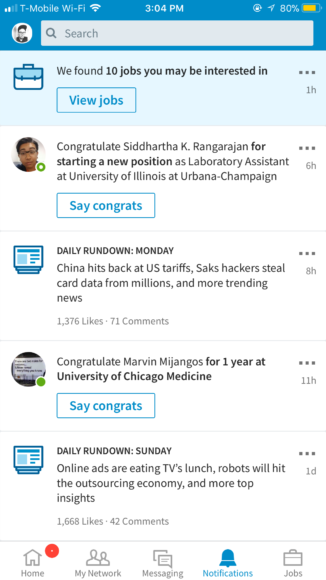
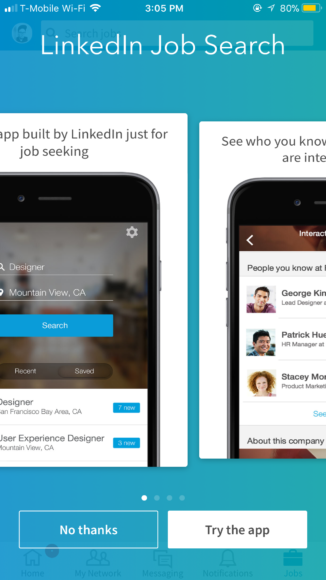

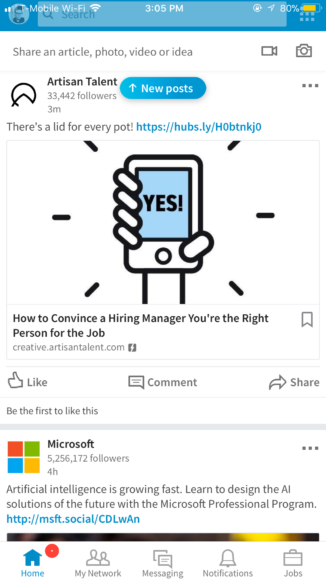
How we’d make social media better
1. Make it so you can filter all posts that may come up on an “explore” page with hashtags or keywords. Gives user a chance to say what they do and what they don’t want to see ever while on social media
2. Get rid of the way that people can buy like, followers, friends. Doesn’t promote the idea of information stealing and fake accounts and just makes the numbers of followers just a bit more realistic.
3. Being able to manipulate the layout or interface offered in social media. Being able to personalize your social media in a way in which you can make some aspects of an interface bigger or smaller depending on how important that is you would be a cool without having the option of completely removing something. This would include being able to simply rearrange things on your interface as well.
4.Not having “recommended posts” based on data tracking
5. Show only what relates to you. not having a friend of a friend post on your timeline
6. Keeping business things separate from casual social media
– Chase and Maggie
0: hidden in plain sight
Recently, I noticed a new (at least to me) feature in Gmail regarding the inbox.
Most of the time, I rush through checking my email, so it’s interesting that I slowed down enough to notice this feature. When you hover over the inbox without clicking, a little arrow appears on the side. Arrows usually mean “I’m hiding something”, so I tried clicking on it to see what would happen.

What I found was a whole bunch of ways to organize your inbox. My favorite one puts all unread messages on the top. I have yet to try this, as I found it overwhelming to look at all of my unread (and old) messages. One day I’ll deal with them, and remember this inbox setting.

Now, this is an observe because of how this little arrow made me behave following its discovery. I proceeded to spend a good amount of time hovering over everything and clicking everything I could see in Gmail, just to find out if anything happened. I didn’t realize it had happened until I finished my quest. Imagine what they could do with the knowledge of how to control me like that…imagine how many other sets of data they’re collecting on us, or could collect on us in a similar manner.
Improving Social Media
Social media is a strange concept because while there are many, MANY drawbacks to it, it is something we seemingly can’t escape, and it has brought many new perspectives and means of communication to life. So many people these days rely on social media for news updates, political discussions, even guidance. While getting rid of it as a whole might seem like it would cure our fixation with social media, it would probably be more destructive considering the heavy reliance on it. Some ways to try and improve social media could be….
1. The option to veto targeted advertisements
2. A tax for companies on certain sites
3. Implementing penalties for abuse or harassment online
4. Helping people understand where there data is going and who can access it
5. Educating on safe network use and how to prevent being hacked
6. Creating jobs designed to identify a variety of social media nuisances (i.e fake accounts, abusive posts or bullying, fake news)
7. Educating ways to increase income with social media or the internet
Observe 8
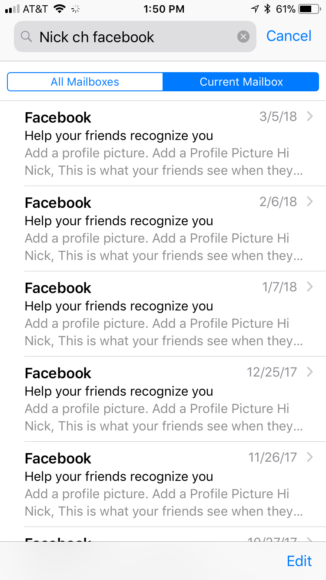
Facebook won’t leave me alone, I made a facebook strictly because my work required it in case of shift covers or communicating with my bosses. I have since left the job, yet facebook still thinks that I require a photo even after it being inactive for more than a year. I have even deactivated the account, yet the emails still keep coming. Facebook just wants my information regardless and I am not inclined to give it to them. I just want it to stop as they have done it sporadically throughout, but consistently every month.
Project 7: Ideas (to interact)
With Niky
- Make everyone anonymous online, no one can actually identify you at all
- Make everyone unable to be anonymous online, no way to hide who you really are
- Social media fact checking all posts before they can be posted
- Automatic spell/grammar check
- Make profiles truly private, no information can be spread in screen shots
- Make photos permanently delectable (i.e. revenge porn)
- Only one post at a time, stop overload, top 10(?)
- Only latest post, can’t go back
- Choose to either be completely anon or transparent
Project 0: Facebook: Share to (8)
The first time I made a post in a while, I got this option. I never saw it again, I think I may have been sharing a video from a public group. At this point, I had already typed out my status as a status because I was planning on posting it to my personal page. I stared at this option page for a while, wonder how I post my normal status. What the hell is a “News Feed?” Why would I post this to my story? It’s a status! If I wanted to send it in messenger, I would have picked that option! Why is Facebook treating me like I’m a 67 year old on social media, holding my hand, giving me an extra safety net so I don’t post something where I don’t want it to be. I guess the video was something I would normally share over messenger, but why was this page made? Is it really an extra safety net or is it just another way Facebook wants you to share and “reach” more people? Like in Snapchat how people post something to their story but also send that same photo to specific people.
News Feed is the new wall I guess? Where did the phrase “status” go? I see that timeline is still being used but I feel that Facebook has started to change a lot of their terminology in the past few years.
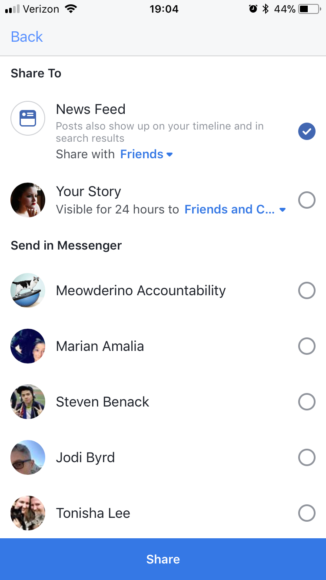
Observation 4/2

Occasionally when I’m reading an article through the Facebook app, a spam popup appears and locks up the screen unless I hit “OK”. The only way to get rid of it is to close out and restart the app entirely because some instinct inside me just knows that clicking OK would invite disaster into my phone. I got one this past week and started wondering, “Where do these popups come from? Doesn’t Apple have super-tight security against malware and spam?” So I started doing some research.
“What enables these ad redirects to haunt virtually any browser or app at any time, rather than just the sketchy backwaters in which they used to roam? Third-party ad servers that either don’t vet ad submissions properly for the JavaScript components that could cause redirects, or get duped by innocent-looking ads that hide their sketchy code…Publishers are particularly vulnerable, because they often rely on third-party ad networks for revenue. As a result, they can find themselves at the mercy of whatever a given ad network doles out. Even if publishers use only reputable services, those ad networks can themselves get duped.”
The biggest mistake people make with technology is assuming that it works the way that you think it does. For example, publishers assuming that third party publishers have properly vetted their content or the ad networks assuming their JS code doesn’t have a secondary, malicious purpose. There’s a lot of potential for these spam popups to cause real damage to mobile devices that likely don’t have any anti-malware programs installed. If companies don’t start regulating the content they provide on their platform then this poses a huge potential security risk to users.
In summary:
- No surprise: they’re pretty bad. The notifications are all either marketing tricks or outright scams, and you may be giving the scammers access to your Facebook page. Redirecting ads can do different types of things—some of them are just a nuisance, but redirecting ads can also drop malware on people’s machines.
- Ways to fix it: Ad purchasers are not well-vetted enough and are given too much leeway with regards to JavaScript code execution. Ad exchanges should crack down on this type of aggressive code with a better screening process.
- An ad hijacking your browser like that isn’t technically a hack, in the sense that it doesn’t exploit a software vulnerability. Instead, it relies on the attacker’s ability to submit and run ads that contain redirecting JavaScript. But though they aren’t a critical threat to web users yet, redirecting mobile ads could create a jumping off point for attackers.
An informative article from Wired in January 2018 (quoted above): link
Observe 8 In Ya Face
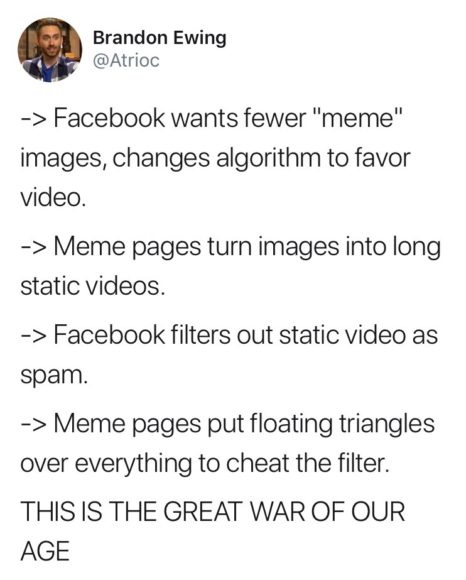
For my observe this is an explanation for something I’ve seen over the course of months concerning facebook and the presentation of memes. I had to do this one right after I found out about it because without it, meme culture on facebook seemed to be having these weird features about them and says a lot about what Facebook is turning into. With the growing amount of memes on facebook, they actually attempted to fight against the amount by changing their post algorithm to favor posted videos instead of picture. Before knowing this I would click on a meme in what would appear to be in image format just to realize it was a video going for several seconds and I thought it was stupid. I would wonder why people just made me look at a video of a still image but come to find out they just want their meme to be seen and passed around more easily. In response facebook makes still image videos go under the category of spam and are blocked. Still before seeing this post I would see similarly still images of a meme in video format but with faint triangular shapes floating around the screen overlaying the video and again wondered its purpose but here it is. This is showing how software shapes the user, or in a sense how user shapes the software. The user’s of facebook desperately want to turn facebook into memebook so they are doing what they can do find the loopholes in facebooks algorithms to get the posts they want to put up to be able to stay up and circulate. This also shows how facebook would actually filter out some people’s posts just because they want their site to have a certain kind of material. This is seriously the battle of the ages and I’m wondering what other implications will facebook come up with to decrease the number of memes and how the community will try to work around it.
Project 5: REPLACE
I’m lowkey panicking right now because I could’ve sworn I posted this weeks ago, but here’s the link to my extension for project 5: https://chrome.google.com/webstore/detail/yt-extension/efmapkadmcjhadmbkfdfbgcdclfdcfbm.